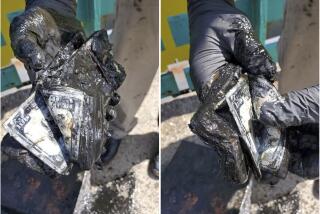Scientists experiment with money laundering
Got some dirty money to launder? Well, Rhode Island scientists say they’ve devised a method of washing human grease, microbes and motor oil from the world’s banknotes using supercritical fluid.
Each year, the world’s governments shred roughly 150,000 tons of cold hard cash due to wear and tear, as well as the buildup of human grease, or sebum, which collects on the bills as they are handed from one person to another.
As the sebum reacts with oxygen in the air, the bills begin to turn yellow, making them more likely to be retired by central banks and destroyed. While well-used bills can be replaced due to tears and limpness, 60% to 80% of all banknotes are removed from service due to soiling.
In a study published Wednesday in the journal Industrial and Engineering Chemistry Research, scientists wrote that effective cleaning of banknotes could reduce the annual global cost of replacing the bills, which now approaches $10 billion.
“Replacement orders can range from 7 to 11 billion banknotes annually in the United States and is approaching 150 billion worldwide, with much of the growth in volume over the past decade coming from the People’s Republic of China,” wrote chemist Nabil Lawandy and physicist Andrei Smuk. Both men hold management positions in the banknote authentication firm Spectra Systems Corp.
In the United States, it costs 5.5 cents to produce a new $1 bill, and about 12.6 cents to produce a new $100 bill, according to the authors. The world average replacement cost is about $65 per 1,000 banknotes.
“In addition to replacing banknotes that are not fit, the central banks have to dispose of nearly 150,000 tons shredded banknotes annually,” the authors wrote. “Although this waste does not contain hazardous levels of toxic materials, it still poses a significant environmental concern.”
To address the issue, the authors constructed a special washing chamber that used supercritical carbon dioxide to scrub grimy dollars, pounds, rupees, rubles and yuan.
Supercritical fluids are substances that maintain liquid and gas properties through manipulation of their temperature and pressure.
If CO2 is heated to 140 degrees Fahrenheit and pressurized to 2,000 pounds per square inch, it will permeate the pores of cotton and linen dollar bills, like a gas, but will also dissolve foreign matter, like a liquid.
The use of supercritical CO2 has the added benefit of being non-poisonous, unlike some commercial solvents, and has been used to clean precision mechanical parts and in dry cleaning.
The authors wrote that the device, which also uses ultrasound, but no mechanical agitation, was effective in removing lab-applied oil that had been allowed to oxidize, as well as microbes.
The authors wrote that the process did not appear to damage anti-counterfeiting watermarks, threads, holograms or ultra-violet excited ink markings. It also showed that bills could be cleaned in 100-note bundles, called “straps.”
Refinement of the money laundering process could, authors wrote, “have dramatic consequences for central bank budgets as well as mitigating the environmental impact of the disposal of unfit banknotes.”






